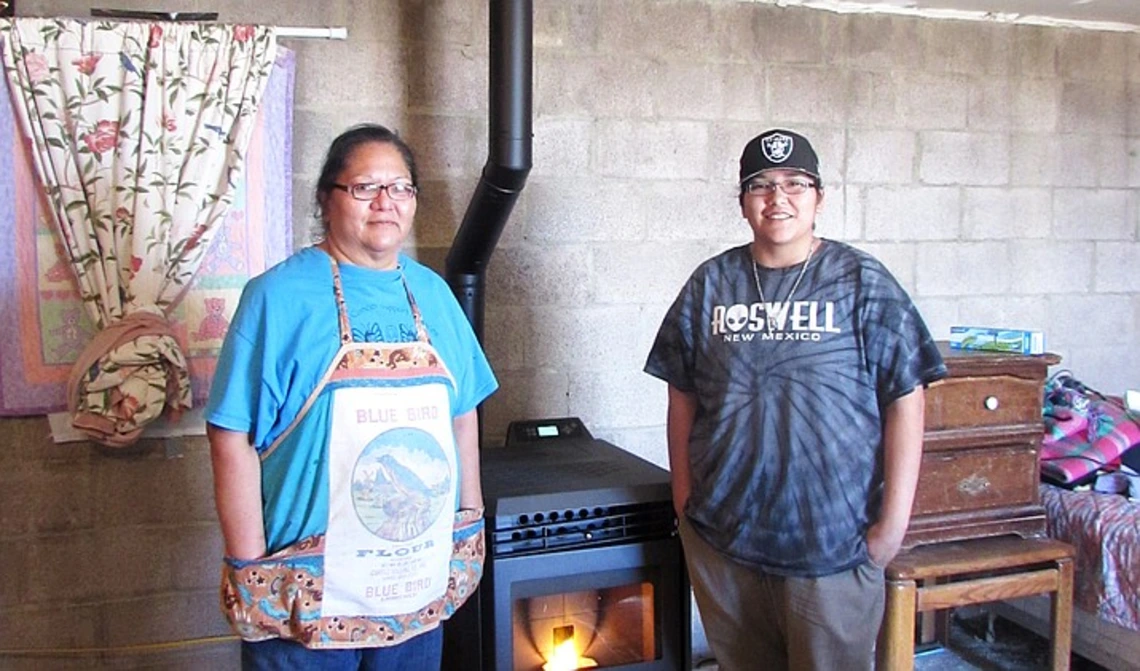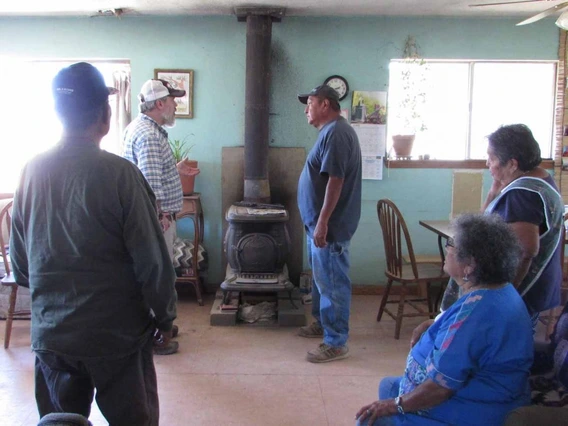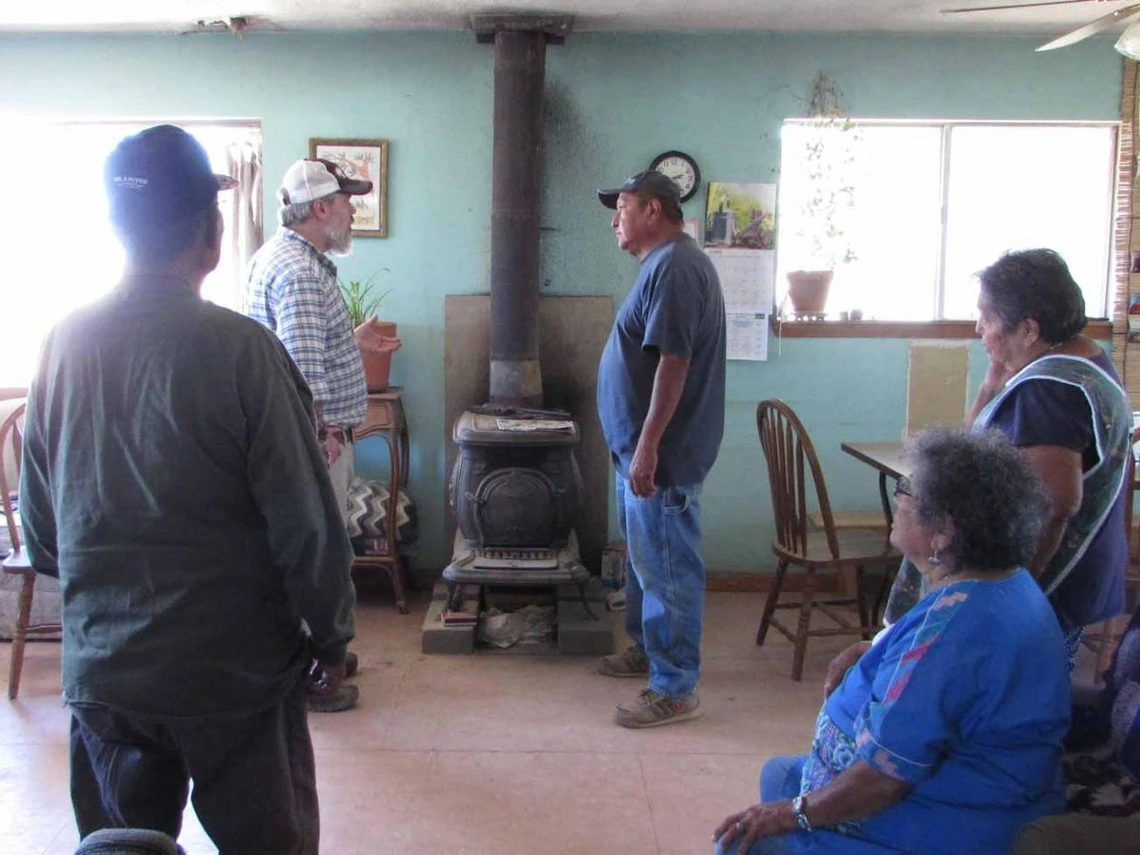Looking for Cheap, Clean Alternatives for Home Heating in Hopi Nation

Over half of all Hopi households rely primarily on coal for home heating. After decades of providing free coal to Hopi families, the Navajo Generation Station closed recently, and Hopi families started looking for alternatives to heat their homes. Wood burning is not option; besides forcing families to travel farther distances and pay higher prices to access to wood, both wood and coal smoke cause long-term respiratory and cardiovascular health effects aggravated by sustained exposure. Census data show that people living on tribal lands are five times more likely to suffer from asthma than those living elsewhere in the US.
The Red Feather Development Group (RFDG), a nonprofit in Flagstaff, Arizona, partnered with Brian Mayer, Associate Professor at UA School of Sociology and former Haury faculty fellow, and Lisa Hardy, professor at Northern Arizona University Department of Anthropology, on a one-year Haury Program seed grant to develop a healthy heating educational class for families of the Hopi Tribe. The red Feather DIY Healthy Heating approach aims to help families find new solutions for staying warm by exploring viable heating alternatives for homes using a combination of education and heating systems’ installation and maintenance training necessary to address the causes.
For many in the US, home heating is done without much consideration of source. A flip of switch, a twist of a dial, or even a smartphone can be used to keep us warm. However, for those who rely on coal to heat their homes, the process is a significant burden. Hopi Tribe families often drive 60 miles one way on a rough dirt road to the Kayenta coal mine, where they fill their trucks by hand. Once home, the large chunks of coal are unloaded and stored outside. Then, throughout the often sub-freezing winters, the coal is brought inside where it is loaded into their stoves. Stoves need to be continually refilled and stoked throughout the day and night. Chimneys need to be cleaned at least once a month during the heating season.
 Of even greater concern than this burden, is the impact coal burning has on human health. It is not uncommon to see ceilings covered in black coal dust and hear complaints of individuals struggling with respiratory ailments or hear of life-threatening overexposure to combustion by-products. Joe Seidenberg of RFDG, Brian Mayer and, Lisa Hardy worked together to identify and help develop locally-appropriate practices to reduce health risks. The research on alternative fuel sources informed the design, piloting, and implementation of an educational intervention program that provides Hopi households with information and resources to reduce exposures to harmful indoor air pollutants. This research is of vital importance in reducing major economic and health disparities related to air quality in homes.
Of even greater concern than this burden, is the impact coal burning has on human health. It is not uncommon to see ceilings covered in black coal dust and hear complaints of individuals struggling with respiratory ailments or hear of life-threatening overexposure to combustion by-products. Joe Seidenberg of RFDG, Brian Mayer and, Lisa Hardy worked together to identify and help develop locally-appropriate practices to reduce health risks. The research on alternative fuel sources informed the design, piloting, and implementation of an educational intervention program that provides Hopi households with information and resources to reduce exposures to harmful indoor air pollutants. This research is of vital importance in reducing major economic and health disparities related to air quality in homes.
Caroline and Robert Lomabalaquihoya live in a one room home on Second Mesa, AZ. It was the middle of the night when they were startled awake by their carbon monoxide monitor going off. “I looked and the whole house was filled with smoke, real, thick smoke,” Carolyn said. Red Feather installed a CO monitor at their home as part of our Do-It-Yourself Home Weatherization workshop, funded as part of this seed grant, that both Carolyn and Robert attended. “We were so thankful they had installed that. I didn’t smell it or anything. It’s a silent killer. We never knew it was happening,” Carolyn said.
During this first year of Red Feather’s Healthy Heating program, 55 attendees learned about the basics of wood and coal stove maintenance, how to improve indoor air quality and prevent house fires, as well as safe, healthy and efficient home heating alternatives. Attendees also received a stove maintenance and safety kit and healthy heating resource guide. Other efforts developed under the program included a public service announcement campaign that aired in a local newspaper and on a community radio station aiming to build broad scale awareness of the healthy heating topics.
Red Feather continues the program and is now looking for home heating alternatives that improve air quality and lower safety risks, have low operating and maintenance costs, are accessible, and culturally appropriate. In the coming months Red Feather will develop a heating demonstration site that pares ductless mini-split electric heat pumps and solar furnaces together to introduce the technologies to the Hopi community and learn more about their performance. The project will be hosted by the Village Kykotsmovi at their community building.
Joe Seidenberg, Red Feather’s Program Director, says, “High levels of poverty and unemployment, geographic isolation and limited access to alternative fuels are creating an alarming situation for families to keep their homes warm during cold winter months. Therefore, Red Feather is investing resources into exploring culturally appropriate alternatives like solar furnaces that could supply free supplemental heat and potentially be manufactured locally.”
Seidenberg adds, “The Haury Program’s investment and collaboration has been instrumental in Red Feather’s ability to develop this important program. Community members are contacting us more and more frequently as they hear of our efforts and local awareness grows around healthy heating issues.” Red Feather’s approach to developing community programs parallels the Haury Program’s own values, which involves extensive collaboration with community partners to ensure efforts respond to local needs and strengthen resiliency to environmental and social justice challenges.
Visit www.redfeather.org for more information about Red FeatherDevelopment Group.
More information about this and other projects funded by the Haury Program here.


